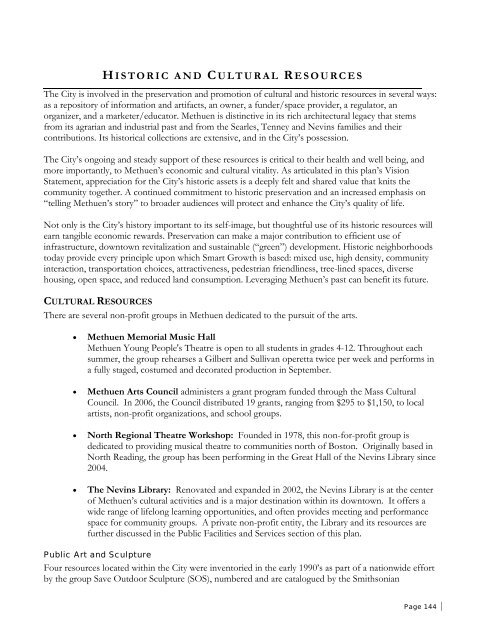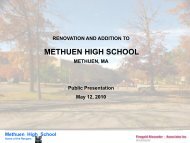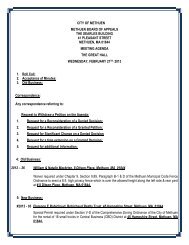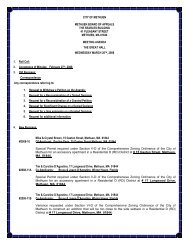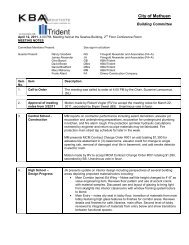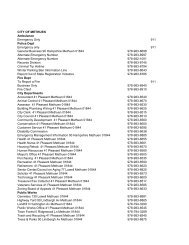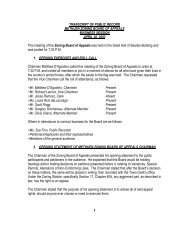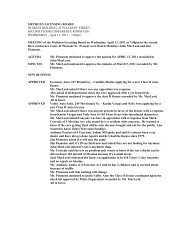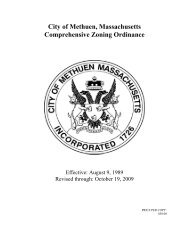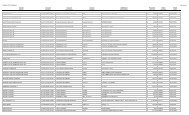City of Methuen Master Plan
City of Methuen Master Plan
City of Methuen Master Plan
You also want an ePaper? Increase the reach of your titles
YUMPU automatically turns print PDFs into web optimized ePapers that Google loves.
H ISTORIC AND C ULTURAL R ESOURCES<br />
The <strong>City</strong> is involved in the preservation and promotion <strong>of</strong> cultural and historic resources in several ways:<br />
as a repository <strong>of</strong> information and artifacts, an owner, a funder/space provider, a regulator, an<br />
organizer, and a marketer/educator. <strong>Methuen</strong> is distinctive in its rich architectural legacy that stems<br />
from its agrarian and industrial past and from the Searles, Tenney and Nevins families and their<br />
contributions. Its historical collections are extensive, and in the <strong>City</strong>’s possession.<br />
The <strong>City</strong>’s ongoing and steady support <strong>of</strong> these resources is critical to their health and well being, and<br />
more importantly, to <strong>Methuen</strong>’s economic and cultural vitality. As articulated in this plan’s Vision<br />
Statement, appreciation for the <strong>City</strong>’s historic assets is a deeply felt and shared value that knits the<br />
community together. A continued commitment to historic preservation and an increased emphasis on<br />
“telling <strong>Methuen</strong>’s story” to broader audiences will protect and enhance the <strong>City</strong>’s quality <strong>of</strong> life.<br />
Not only is the <strong>City</strong>’s history important to its self-image, but thoughtful use <strong>of</strong> its historic resources will<br />
earn tangible economic rewards. Preservation can make a major contribution to efficient use <strong>of</strong><br />
infrastructure, downtown revitalization and sustainable (“green”) development. Historic neighborhoods<br />
today provide every principle upon which Smart Growth is based: mixed use, high density, community<br />
interaction, transportation choices, attractiveness, pedestrian friendliness, tree-lined spaces, diverse<br />
housing, open space, and reduced land consumption. Leveraging <strong>Methuen</strong>’s past can benefit its future.<br />
CULTURAL RESOURCES<br />
There are several non-pr<strong>of</strong>it groups in <strong>Methuen</strong> dedicated to the pursuit <strong>of</strong> the arts.<br />
• <strong>Methuen</strong> Memorial Music Hall<br />
<strong>Methuen</strong> Young People's Theatre is open to all students in grades 4-12. Throughout each<br />
summer, the group rehearses a Gilbert and Sullivan operetta twice per week and performs in<br />
a fully staged, costumed and decorated production in September.<br />
• <strong>Methuen</strong> Arts Council administers a grant program funded through the Mass Cultural<br />
Council. In 2006, the Council distributed 19 grants, ranging from $295 to $1,150, to local<br />
artists, non-pr<strong>of</strong>it organizations, and school groups.<br />
• North Regional Theatre Workshop: Founded in 1978, this non-for-pr<strong>of</strong>it group is<br />
dedicated to providing musical theatre to communities north <strong>of</strong> Boston. Originally based in<br />
North Reading, the group has been performing in the Great Hall <strong>of</strong> the Nevins Library since<br />
2004.<br />
• The Nevins Library: Renovated and expanded in 2002, the Nevins Library is at the center<br />
<strong>of</strong> <strong>Methuen</strong>’s cultural activities and is a major destination within its downtown. It <strong>of</strong>fers a<br />
wide range <strong>of</strong> lifelong learning opportunities, and <strong>of</strong>ten provides meeting and performance<br />
space for community groups. A private non-pr<strong>of</strong>it entity, the Library and its resources are<br />
further discussed in the Public Facilities and Services section <strong>of</strong> this plan.<br />
Public Art and Sculpture<br />
Four resources located within the <strong>City</strong> were inventoried in the early 1990’s as part <strong>of</strong> a nationwide effort<br />
by the group Save Outdoor Sculpture (SOS), numbered and are catalogued by the Smithsonian<br />
Page 144


